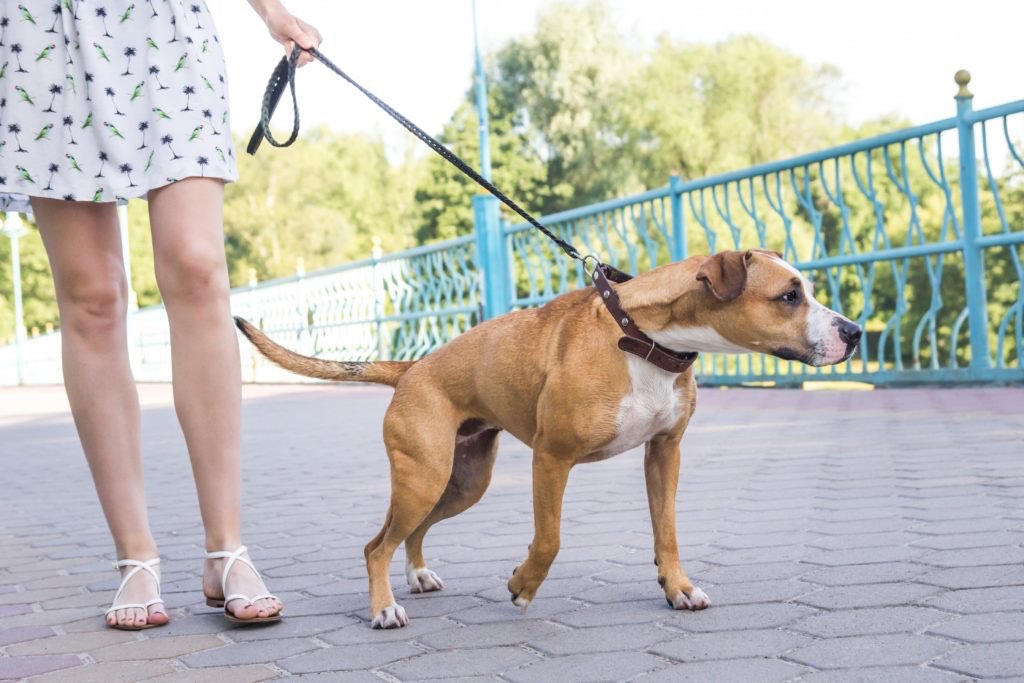Leash pulling can can cause some serious relationship issues between you an your dog. Your in the mood for a leisurely stroll, but you pooch, bless it’s energetic little heart, want’s a full blown 5K. This is something dog walkers work with on the regular. Dogs pull because they want their slow humans to hurry up! It can become quite a fun game of “how fast can I get my human to run to the park?” There can be serious risks if you don’t address this behavior. Falling injuries, found food, and loss of control are all risky business. Pulling can be pretty dangerous for humans and dogs. It is always safer and more fun to have a pooch with good leash manners. Luckily there are some great solutions and techniques to help curb leash pulling!
Try a Harness
The EZ Walk Harness
An EZ Walk harness, or other “chest-led” harness, can be a major life saver and almost eliminate pulling. I got one for my pit-bull puppy and it basically cured her pulling problem overnight. These harnesses are effective because they re-direct any leash pull back towards you. They are a super safe alternative to prong or choke collars since they do not constrict the dog’s throat.
Gentle Leader
“Gentle Leaders” or “Snoot Loops” are another great option for dogs that pull. The catch with these snout-led leads are that not all dogs are okay with having something around their nose. Some dogs will reject these leads by refusing to walk and trying to pry it off with their paws. However if your dog is okay with it, these very effectively redirect any pulling back towards you. They are particularly excellent for dogs that love to lunge at food scraps on the sidewalk.
Do Some Training
In order to leash train your dog to not pull you will need patience, and a lot of it. The best way to leash train your dog is to stop in your tracks as soon as the dog pulls. This may result in you taking a whole hour to get around the block since you may have to stop at every step. It can help to listen to the news or bring a friend to entertain you during this tedious process. Without using commands, wait for your dog to sit down. Once he eventually sits give him lots of verbal praise, treats, and allow him to keep walking. Then, as soon as he starts pulling again (which may be .03 seconds later) repeat the process. Warning: at first your dog will most likely pull more, after all that’s what’s worked for him in the past! Unfortunately, doggie behavior often gets worse before it gets better. Feel free to give lots of treats when they are walking with a loose leash.
You should be prepared to leash train on every walk until your dog learns proper manners. Some people don’t mind their dog walking ahead of them with a little slack and others want their dog to stay on their left side the entire time. Do what makes you comfortable!
For more information on leash training, check out Ian Dunbar’s guide here: http://dogtime.com/dog-health/general/1530-dog-training-walking-on-leash-dunbar
Other Tips
- Some dogs respond well to their humans talking to them as they walk. You talking to your dog may make you look like a crazy person, but It may also motivate your dog to stay close to you. For the record, you would be surprised how well dog names fit into Barry Manilow lyrics.
- If your dog is a complete loony toon as soon as you get outside because of distractions like squirrels, construction, cats, children, garbage, etc. you can practice leash training somewhere less stimulating in the house or the yard.
- “Choking up” or shortening the leash is also a good strategy to use when leash training at first. The shorter the leash, the more control you have.
- Try to tire your dog out a little bit by playing fetch or going to the dog park before you attempt to leash train. A tired pup is a well behaved pup!
- Leash train before breakfast and dinner when your dog is hungry. The hungrier the dog, the more treat motivated he will be.
- Use “high value” treats such as chicken, turkey, or cheese when leash training. This can really make a gigantic difference!

